You have had a drain tube placed into space inside your body. This small tube comes out through your skin. It drains blood, infection, or fluid into a bag outside your body.
Caring for your drain tube
It is very important to take care of your drain tube to help prevent an infection. You should:
· Change the bandage and clean the skin around the drain tube. Do this at least once a week or more often if the bandage gets wet or dirty.
· “Flush” the drain tube to keep it from getting clogged. Do this twice a day – once in the morning and once in the evening (or more often if your doctor tells you).
Below are detailed instructions on how to change your bandage, clean around the drain tube, and flush the drain tube. There is also information on bathing, taking antibiotic medicines, and follow up visits.
Changing the bandage
Change the bandage and clean the skin around the drain tube at least once a week. If the bandage gets wet or dirty, change it and clean around the drain tube, even if you just changed the bandage the day before.
You may change the bandage yourself or a family member or friend may do it for you.
You need these supplies when you change the bandage and clean around the drain tube.
· Plain soap and warm water or an alcohol-based hand cleaner
· Disposable medical gloves – (optional) they do not have to be sterile
· Gauze pads (4x4s) -- you will need a total of four (4)
· Clean wash cloth
· Medical tape
· Trash bag
Step 1. Remove the old bandage
· Gently remove the old dressing being sure not to pull on the tube.
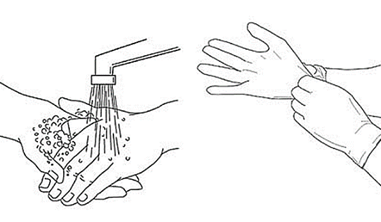
· Wash hands and put on gloves (if wearing gloves).
· Carefully remove the old bandage. Press on the skin next to the drain tube with one hand and gently remove the tape with the other hand.
· Throw the old bandage in the trash bag.
· Look for signs of infection. Is the skin:
○ red
○ swollen
○ tender to the touch
○ pulled away from the drain tube
Call your doctor if you have any of these signs of infection.
Step 2: Clean the skin.
· Hold the drain tube in place while you are cleaning around it so it does not pull out.
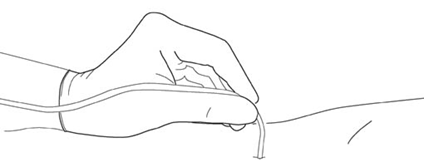
Carefully hold the drain in place.
· Wet a gauze 4x4 with soap and water.
· Start cleaning where the drain tube comes out of the skin.
· Wipe the skin gently in a circle, moving away from the drain tube in bigger and bigger circles.
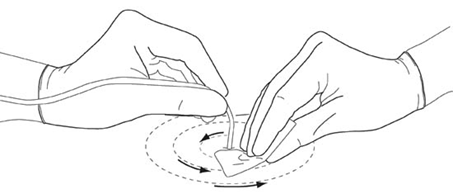
Clean the skin carefully.
· Gently pat the skin with the clean washcloth until it is dry.
Step 3: Put on a fresh bandage: two clean gauze 4x4s and tape.
· Fold each gauze in half.
· Place one on top of the drain tube.
· Place one under the drain tube.
· Tape on all sides.

Tape on a new bandage.
Flushing your drain tube
Your doctor may want you to flush your drain tube daily. This helps keep the drain tube from getting clogged. Flush it as frequently as the doctor orders.
You will need these supplies to flush your drain tube:
· Plain soap and warm water or an alcohol-based hand cleaner
· Disposable medical gloves – (Optional) they do not have to be sterile
· Stopcock or Adaptor Tube (See Last page for Directions) – we will give you one to take home
· Saline solution – this comes in pre-filled syringes; you can buy these at most drug stores
· Trash bag
How to flush the drain tube:
· The person cleaning the drain tube should wash their hands with soap & water or hand cleaner and put on a new pair of medical gloves if they choose to.

Wash hands and put on gloves (if wearing gloves).
· Open the package of saline in a syringe.
· Unscrew and remove the cap on the drain tube. Put the cap on a clean surface so that nothing touches the inside of the cap. If anything touches the inside of the cap, germs could get into your drain tube and you could get an infection.
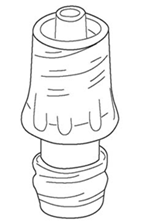
Drain tube cap.
• Turn the stopcock on the drain tube to the “on” position.

• Slowly push the 10ml of saline solution into the drain tube.
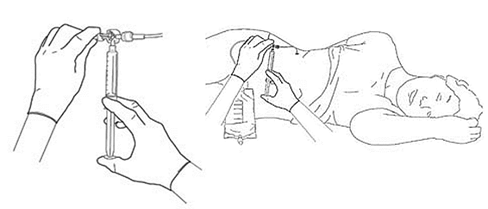
• Attach syringe and flush drain tube.
• Turn the stopcock to the “off” position.
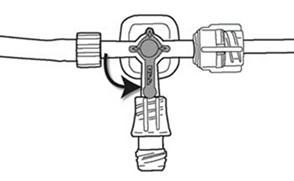
Turn the stopcock to the “off” position.
· Remove the syringe.
· Screw the cap back on the drain tube. Use a new cap if you are not sure the old one is clean.
· Remove your gloves and throw both the syringe and your gloves in the trash.
How to Flush Your Drain
Please Note: Depending on where your drain site is, your care team might have used a connector for your drain that looks like the one below. It does not have a "stopcock."

Follow these steps to flush this type of drain tube
1. Wash hands: The person cleaning the drain tube should wash their hands with soap and water or hand cleaner. They can also put on a new pair of medical gloves if they want to.
2. Close the clamp: Close the plastic clamp. This makes sure the fluid goes into the part of the tube that's inside the body – and not straight into the drainage bag.
3. Open saline package: Open the package of saline in a syringe.
4. Clean the port: Clean the needleless port with an alcohol wipe. If you don't have alcohol wipes, use warm soapy water and a clean cloth. Hold the drain securely with one hand, then scrub the port back and forth for 15 seconds to remove germs.
5. Attach the syringe: Attach the syringe to the needleless port with a push-and-twist motion.
6. Flush the tube: Push on the end of the saline syringe to flush the fluid through the tube.
7. Remove and dispose: Untwist the empty syringe and throw it away. (Next time you flush, use a new syringe.)
8. Unclamp the clamp: When you do this, you should see the saline you just flushed flow into the drainage bag. (You might also see pus or blood mixed with the saline going into the bag.)
Flushing the tube as ordered by your doctor helps keep your tube from getting blocked.
*** If your drain does have a stopcock, follow the instructions in the section labeled “Flushable Drain Tube.” ***
Bathing
· Do not take a tub bath or swim or sit in a hot tub while you have a drain tube.
IF this is unavoidable, cover the entire site with an occlusive waterproof dressing to prevent it from getting wet.
· Do take showers, but keep the area around the drain tube dry. Keep it dry by taping a piece of plastic wrap over it or by wrapping plastic wrap around your body to cover it.
Antibiotics
· Your doctor may want you to take an antibiotic.
· Follow the instructions on the antibiotic medicine bottle.
· Make sure you take all of the antibiotic. Don’t stop taking it before you have finished all the pills unless your doctor tells you.
Follow up visit
· It is important to return for a follow-up visit in 1-2 weeks to have your drain tube checked.
· Write down any questions you have for the doctor and take them with you.
· Make a list of the medicines you are taking and take it with you, or take in the actual medicines in their original bottles.
Vascular & Interventional Radiology Clinic
Kentucky Clinic, 1st floor
740 S. Limestone, Room E101
Lexington, KY 40536
859-562-1906